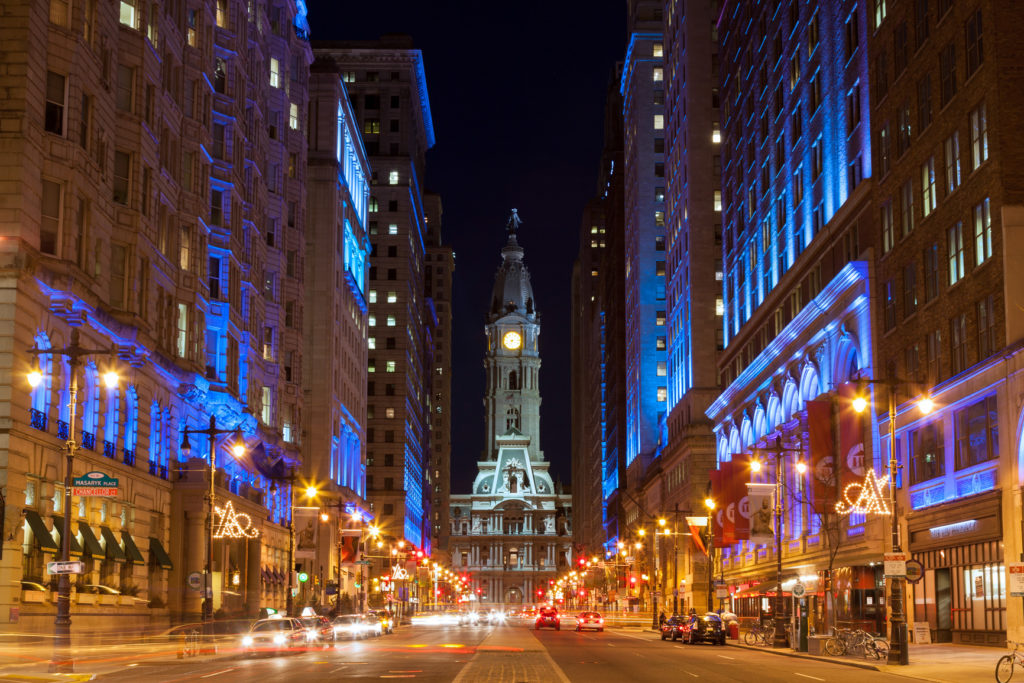It all began back in 1987, when William Penn, (perched atop City Hall) was dwarfed by a taller skyscraper. At the time, the city’s office vacancy rate was 12%, but like many other former industrial hubs, Philly’s population had been dwindling and companies were being lured out to the suburbs. With the end of the “gentlemen’s agreement” that had prevented buildings from being taller than Penn, Philly’s skyline was transitioning, giving way to new commercial real estate opportunities.
Fast forward to 2008, the completion of the Cira Center and the Comcast Center marked the start of a new era for reviving Center City and the region. The highly educated workforce, reasonable cost of living and quality of life for employees began to attract top tier employers. More than $1 billion was allocated to transition The Navy Yard into a modern facility. It’s now home to 145 businesses, many with recognizable names like GlaxoSmithKline and Urban Outfitters. It was recently announced that a 94,000 square foot spec building was going up. The Convention Center’s successful 2011 expansion has spurred a renewal in Center City commercial properties, including a multi-million dollar revitalization of parts of Market Street. The Comcast Innovation & Technology Center, currently under construction, signifies a new level of demand for vertical, high-end development.
Many of these new employers and developments are delivering the next generation of office, industrial and life style properties. Finding creative ways to replace or adapt older properties to meet the new demand is the next challenge. New buildings are garnering rent prices of 30 to 50% higher than available existing properties. Demand for high end commercial real estate, and limited supply, has made Philadelphia one of a few markets reaching prerecession peak rent numbers. Big space occupiers like Cigna are part of the latest group vying for limited Class A space. The industrial market is in a similar situation with distribution companies eying Philadelphia’s easy accessibility to major highway arteries, a port, rails and airports. Upper Merion will soon be home to a $52 million dollar FedEx distribution center as result of its proximity to these assets. In order to continue this positive growth, new sites in the vicinity of center city need to be developed.
The right fit in commercial real estate for now is focusing on the millennials, more specifically those who want to work and live in the urban areas. Technology companies are one of the most sought after tenants and University City is positioning itself to become the innovation hub of the Mid-Atlantic, cultivating start-ups then leasing them space to stay in the area. University of Pennsylvania is in the midst of a multi-million “forward thinking” development along the Schuylkill River banks. Billions of dollars will be spent to build the ever popular mixed use developments, especially in University City to keep millennials happy both in work and play.
Another big driver behind demand for premium space is the medical field. Medicine has been a mainstay for Philly, from opening our country’s first hospital and medical school to having one of the best children’s medical centers in the world at CHOP. Continuing to attract top medical researchers and biotech firms means providing state of the art facilities. Hospital systems are snatching up surrounding city properties to repurpose, even rebuild to fit the growing medical needs. With the primary research hubs near the universities, the medical field is also developing away from centralized locations as they continue to seek out places for doctors’ offices, rehabilitation centers and walk-in clinics.
There’s also a push to keep looking beyond the city limits for available opportunities. Suburban developers are keen on keeping and even enticing more businesses. It’s why places like the Great Valley Corporate Center underwent a multi-million facelift that included the addition of a six story building occupied by Vanguard. The developers saw new opportunities with the interchange connecting Malvern to the PA turnpike. It’s the same hope, that an interchange in Conshohocken will spur greater interest in a $500 million dollar development in the area. Similarly, industrial areas along the Delaware River are getting monetary opportunities in hopes of making new and available for additional manufacturing and industrial investment.
In the next year, two key events- the Pope’s visit and the Democratic National Convention- will certainly put Philadelphia in a positive spotlight. They present a great opportunity to highlight Philadelphia’s ability to move forward without losing sight of William Penn’s utopian city planning to make Philly feel more like a “great towne” than a large city. Under his watchful eye, Philadelphia will continue to be one of the most livable cities in the nation where the Live/Work lifestyle has been thriving for centuries.

